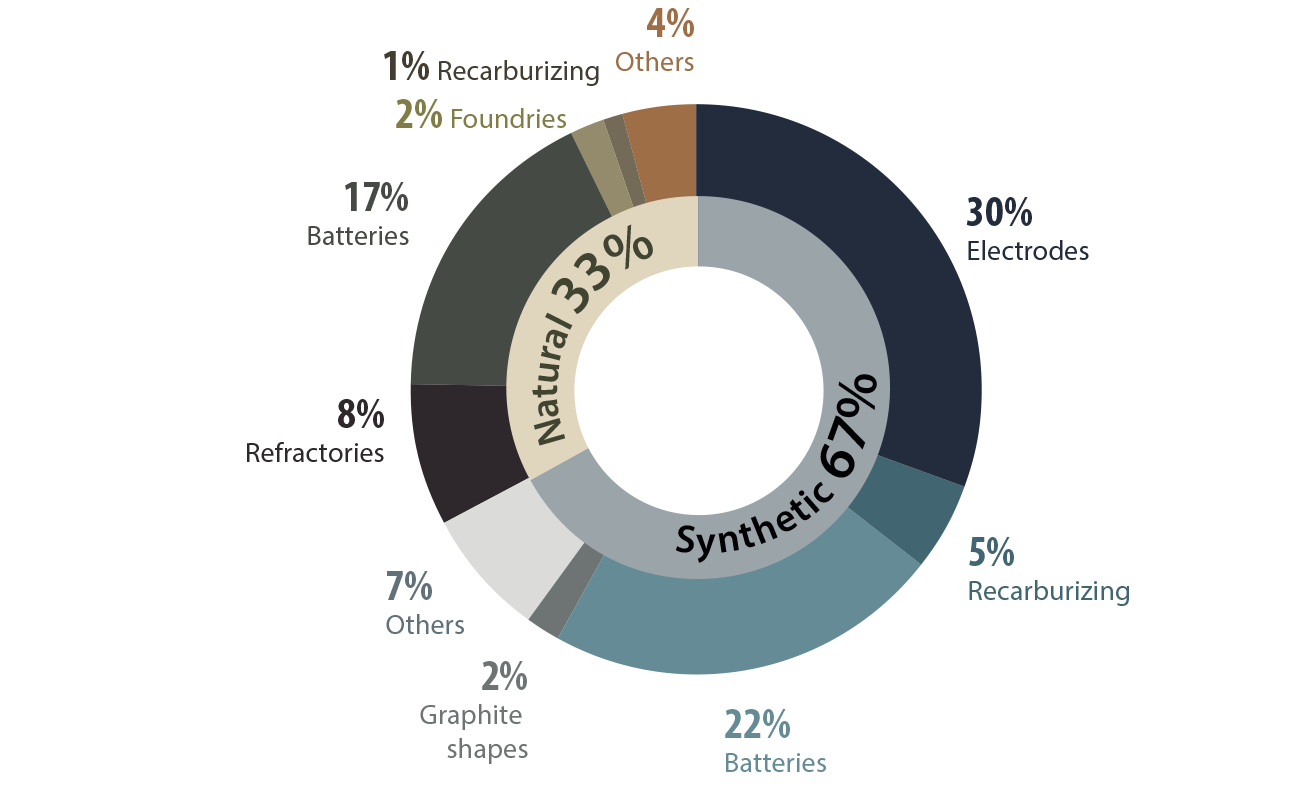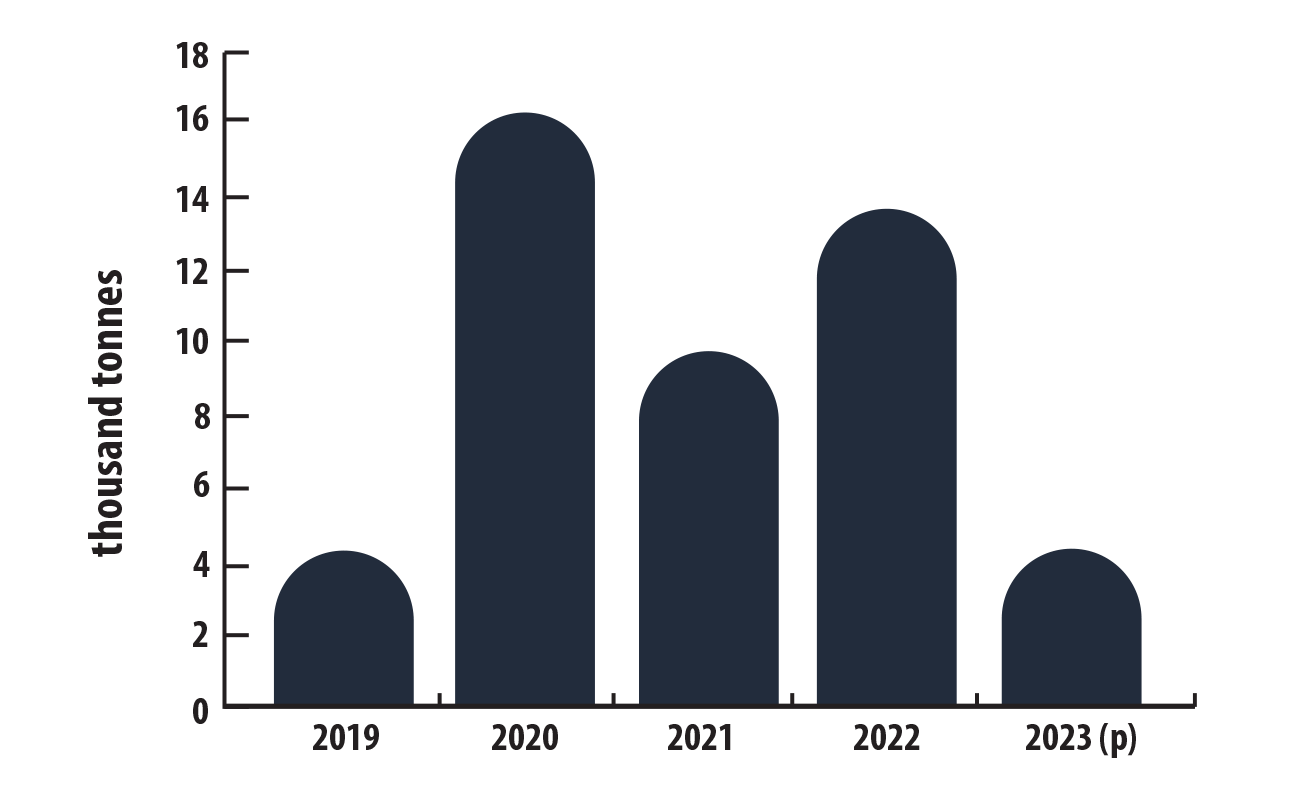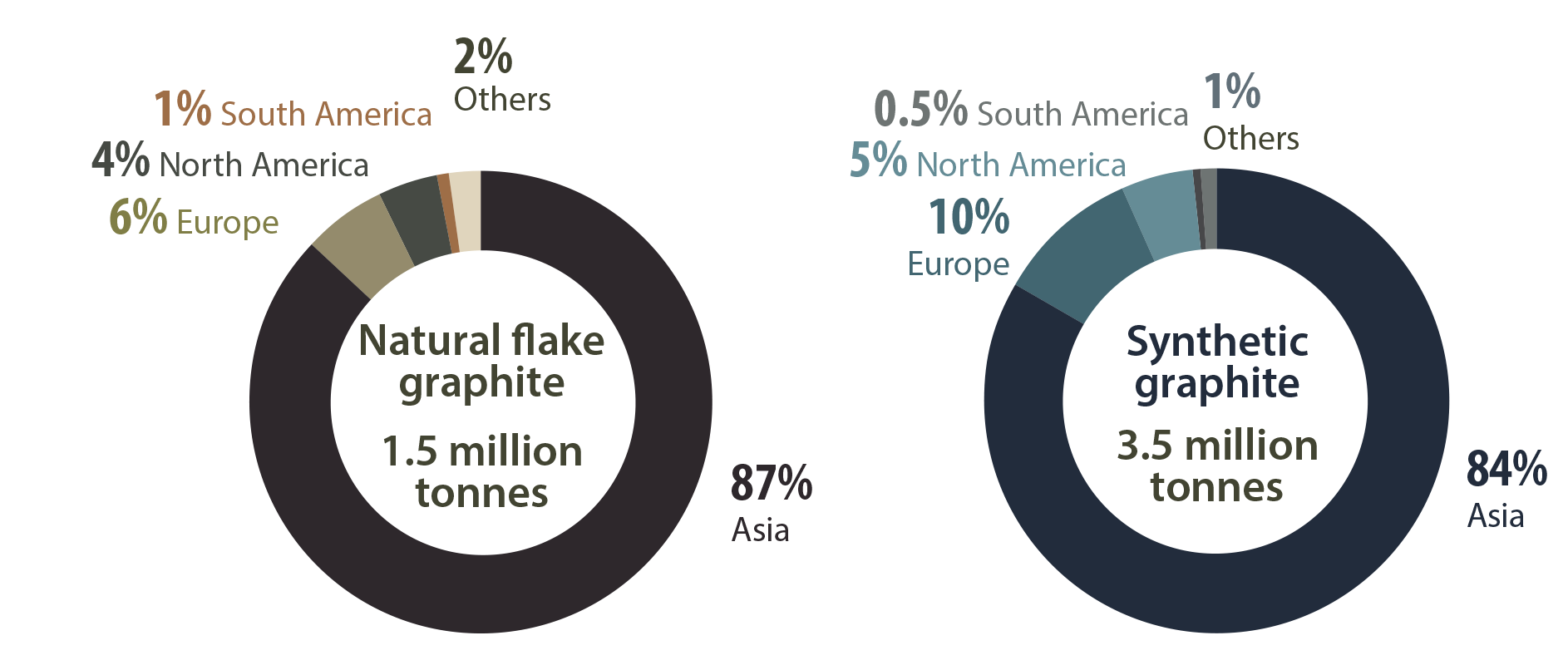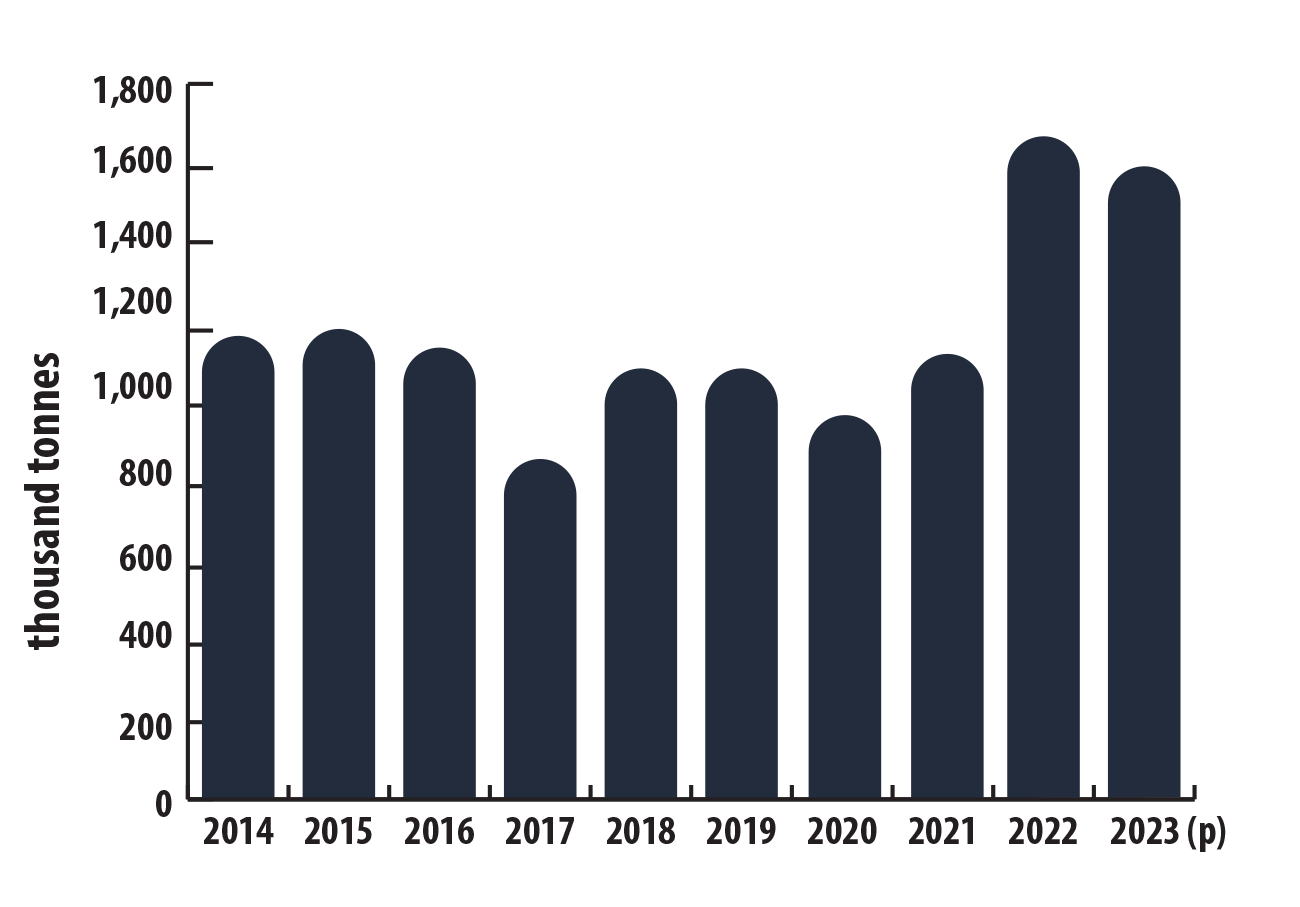
Graphite is a non-metallic mineral that has properties similar to metals, such as a good ability to conduct heat and electricity. Graphite occurs naturally or can be produced synthetically. Purified natural graphite has higher crystalline structure and offers better electrical and thermal conductivity than synthetic material.
Key facts
- In 2023, global graphite mine production reached about 1.6 million tonnes, a 23% increase from 2022.
- Canada was the eleventh-largest global producer of graphite in 2023, with 4,261 tonnes of production.
- In 2023, Canada exported $18 million worth of natural graphite and $14 million worth of synthetic graphite, primarily to the United States.
Learn more about graphite
 Uses
Uses
Natural and synthetic graphite are used in various applications, including electrodes, refractories, batteries, lubricants and foundry products. Coated spherical graphite is used to manufacture the anode in lithium-ion batteries. High-grade graphite is also used in fuel cells, semiconductors, LEDs and nuclear reactors.
Graphite, global uses, 2023

Text version
This circular chart shows the major global uses of natural (33%) and synthetic (67%) graphite. Synthetic graphite is used for electrodes (30%), batteries (22%), recarburising (5%), graphite shapes (2%) and others (7%). Natural graphite is used for batteries (17%), refractories (8%), foundries (2%), recarburising (1%) and others (4%).
 Production
Production
The Lac des Iles mine in Quebec was the only active graphite-producing mine in Canada in 2023. However, several other companies are actively advancing graphite projects. In 2023, Canada produced 4,261 tonnes of natural graphite, a significant decrease from the 13,597 tonnes produced in 2022.
Consult Canada's Critical Minerals Map for more information on advanced projects.
Canadian mine production of graphite, 2019–2023 (p)

Text version
This bar graph illustrates the annual production from natural graphite mines from 2019 to 2023. In 2019, production was 4,332 tonnes but increased significantly o 16,239 tonnes in 2020, before decreasing to 9,743 tonnes in 2021. In 2022, production increased to 13,000 tonnes but decreased to 4,261 tonnes in 2023.
 International context
International context
Global production and demand for graphite are expected to rise primarily because of its use in electric vehicle batteries. In 2023, global graphite consumption reached 5.2 million tonnes, up from 4.7 million tonnes in 2022. Synthetic graphite was about 67% of total graphite consumption, with most of this demand in Asia. North America consumed about 4.1% of global natural graphite and 5.5% of synthetic graphite.
Global consumption of graphite by type and region, 2023

Text version
These pie charts illustrate the distribution of graphite consumption by type and region in 2023. Asia consumed 87% of the 1.5 million tonnes of natural flake graphite used worldwide. Europe consumed 6%, North America 4%, South America 1%, and other regions 2%.
Similarly, Asia led in synthetic graphite consumption, accounting for 84% of the 3.5 million tonnes consumed globally. Europe consumed 10%, North America 5%, South America 0.5% and other regions 1%.
Global graphite mine production was 1.6 million tonnes in 2023, a 23% increase from the previous year. China was the world’s leading producer, accounting for 77% of total production. Canada ranked 11th, producing about 0.3% of the world’s natural graphite.
| Ranking | Country | Thousand tonnes | Percentage of total |
|---|---|---|---|
| 1 | China | 1,230.0 | 77.4% |
| 2 | Madagascar | 100.0 | 6.3% |
| 3 | Mozambique | 96.0 | 6.0% |
| 4 | Brazil | 73.0 | 4.6% |
| 5 | Republic of Korea | 27.0 | 1.7% |
| 6 | Russia | 16.0 | 1.0% |
| 7 | India | 11.5 | 0.7% |
| 8 | North Korea | 8.1 | 0.5% |
| 9 | Norway | 7.2 | 0.5% |
| 10 | Tanzania | 6.0 | 0.4% |
| 11 | Canada | 4.3 | 0.3% |
| Other | 9.4 | 0.6% | |
| World total (rounded) | 1,588.5 | 100.0% |
World mine production of graphite, 2014–2023 (p)

Text version
This bar graph illustrates the global annual production from graphite mines from 2014 to 2023. In 2014, global graphite production was 1.176 million tonnes, increasing slightly to 1.188 million tonnes in 2015. Production decreased to 1.149 million tonnes in 2016 and further to 0.897 million tonnes in 2017.
The amounts fluctuated from about 1.123 million tonnes in 2018 and 1.100 million tonnes in 2019 to 0.965 million tonnes in 2020. Production increased to 1.130 million tonnes in 2021, then surged to 1.680 million tonnes in 2022. In 2023, global graphite production fell 5% to 1.600 million tonnes.
World reserves of graphite
In 2023, global graphite reserves were estimated at 280 million tonnes. China holds the largest reserves, followed by Brazil and Mozambique, with these three countries collectively accounting for 63% of the world's graphite reserves.
Canada ranks ninth globally, with an estimated 5.9 million tonnes of graphite reserves, representing 2.1% of the global total.
| Ranking | Country | Million tonnes | Percentage of total |
|---|---|---|---|
| 1 | China | 78.0 | 27.9% |
| 2 | Brazil | 74.0 | 26.4% |
| 3 | Mozambique | 25.0 | 8.9% |
| 4 | Madagascar | 24.0 | 8.6% |
| 5 | Tanzania | 18.0 | 6.4% |
| 6 | Russia | 14.0 | 5.0% |
| 7 | India | 8.6 | 3.1% |
| 8 | Turkey | 6.9 | 2.5% |
| 9 | Canada | 5.9 | 2.1% |
| 10 | Mexico | 3.1 | 1.1% |
| Other | 22.5 | 8.0% | |
| Total | 280.0 | 100.0% |
 Trade
Trade
In 2023, the value of Canada’s domestic graphite exports reached $32.0 million, marking an 11.1% decrease from the previous year. Conversely, imports rose by 26%, totaling $32.5 million.
Natural graphite accounted for 56.1% of Canada's graphite export value and 26.2% of graphite imports, while synthetic graphite made up 43.9% of exports and 73.8% of imports.
The United States was the leading destination for Canada’s graphite exports in 2023, receiving 83% of natural graphite and 62% of synthetic graphite. Additionally, Canada exported natural graphite to 21 other countries and synthetic graphite to 20 other countries.
 Prices
Prices
The market price for graphite is not readily available because transactions for both natural and synthetic graphite are typically negotiated directly between buyers and sellers.
Natural graphite prices are influenced by several factors, including graphite content, flake size and impurity levels.
As the world’s largest producer, China has a significant impact on international prices, which are generally set by large, high-volume buyers and tend to be conservative. Smaller buyers often face higher prices.
 Recycling
Recycling
The market for recycled refractory graphite material is currently modest but growing because the recycled material is now used in products such as brake linings and thermal insulation.
Although graphite is not typically recovered from recycled lithium-ion batteries, a Quebec-based company is developing a hydrometallurgical process to reclaim most of the battery's raw materials, including graphite.
Notes and sources
(p) preliminary
Totals may be different because of rounding.
Uses
- Graphite, global uses, 2023
- Source: Wood Mackenzie
Production
- Canadian mine production of graphite, 2019–2023 (p)
- Natural Resources Canada
- Data prior to 2017 are suppressed by the source.
International context
- Global consumption of graphite by type and region, 2023
- Wood Mackenzie
- World mine production of graphite, by country, 2023 (p)
- United State Geological Survey
- Canadian values supplied by Natural Resources Canada
- World mine production of graphite, 2014–2023 (p)
- United States Geological Survey
- World reserves of graphite, by country, 2023 (p)
- United States Geological Survey
- Canadian values supplied by Natural Resources Canada, company reports. Values include reserves (proven and probable) at producing mines and advanced projects.
Trade
- Natural Resources Canada; Statistics Canada
- Trade data include the following graphite products: natural graphite, in powder or in flakes (HS code 2504.10); natural graphite; other (HS code 2504.90); and artificial graphite (HS code 3801.10).
Recycling
- United States Geological Survey
- Lithion Recycling (company)